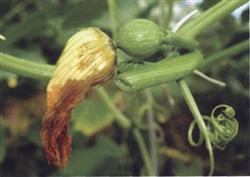Key points of yield increasing technique of pumpkin multi-plant joint grafting

When the main vines of two or more pumpkins are joined together to grow a new main vine, which is nourished by multiple roots, the yield of pumpkin can be doubled and its quality can be greatly improved. The main technical points are as follows: the hole is dug about 10 days before planting, and the size and depth of the pit are twice as large as those of conventional cultivation. More organic fertilizer is applied in the hole, and phosphorus and potassium fertilizer are added. After mixing the fertilizer soil evenly, the covered soil fills the hole, making it slightly higher than the ground. There are 2 to 4 pumpkin seedlings planted in each hole, with a distance of 25 cm. Cut and connect the pumpkin seedlings when the main vine grows to 60 cm long. First, cut off the tips of the main vines of the two adjacent melon seedlings with a sharp knife, the cut sections should be relative and consistent, the shape and size should be basically the same, and then the two sections should be closed and fastened, and the lateral vines and buds on the lower plants of the interface should be erased at the same time. After 2-3 days, the interface can merge and grow new vines. When the new main vine grows to 50-60 cm long, it will be grafted with the third adjacent main vine in the same way. Or the adjacent two new main vines that have been connected together to form 4 parallel plants. Remove the overgrown vines and grow them at the interface, only the long vines do not blossom, and must be removed in time. The difference between the long vine and the new main vine is that the long vine is located below the interface and grows very fast, which can grow more than 10 centimeters a day; the new main vine (melon vine) grows on the back of the interface and grows slowly but sturdily. Note: when ① cutting and joining the main vine, the bud point on the back of the cut should be protected, the new bud point should be exposed when binding the interface, so that the bud point can form a new main vine (melon vine) as soon as possible; at the same time, the leaves below the interface should be protected to facilitate photosynthesis, so that the interface can heal as soon as possible and the new main vine can grow quickly. ② parallel operation should be carried out after 4: 00 p. M. on cloudy or sunny days, and pay attention to prevent hot sun exposure after sunny days; and within 2 days, avoid Rain Water scouring the interface and strictly prevent the bandage from loosening or falling off. When there are 2 or 3 new vines in ③, only one strong main vine should be retained, and the rest should be removed in time. During the growth process after ④, more phosphorus and potassium fertilizer should be applied, and less nitrogen fertilizer should be applied. In protective cultivation, the effect of increasing yield was more significant by applying carbon dioxide gas fertilizer at flowering and melon-bearing stage.
- Prev

Chemical control measures of pumpkin flower rot
Symptoms: also known as fruit rot. Open field and protected land occur frequently, and the protected land is particularly serious. the damage has been on the rise in recent years, and the output has been reduced by about 30%. It is called flower rot or fruit rot when harming pumpkins, melons and watermelons, and brown rot, commonly known as rotten eggs, when harming squash and zucchini. Flower rot damages the flowers and young fruits of pumpkins.
- Next

Watering and fertilization methods of Pumpkin
Symptoms: damage to leaves and rachis. Leaf spots rounded to suborbicular or amorphous. The leaf margin is dark brown, the junction of the sick part is moist, when the humidity is high, the spot is dense with small black spots, serious leaf spot fusion, causing local death of the leaf. The rachis or flower is black and moist, or black-brown rotten. Pathogen: pumpkin leaves.
Related
- Where is it suitable to grow horseradish in China? it is expected to see the middle altitude horseradish in Alishan.
- How to prevent tomato virus disease reasonably? (Control methods included)
- Many people like to plant towel gourd on the balcony. What are the main points of this method and management?
- What crops can chili peppers be mixed with?
- Fertilization techniques and matters needing attention in Tomato
- What are the grafting techniques for peach seedlings in spring?
- Harm and control methods of root swelling disease of Chinese cabbage
- What are the pests of sweet potatoes? How to prevent and cure it?
- Symptoms, causes and Control methods of navel Rot in Tomato
- The cause of "Cucumber rotten bibcock" in Farmers' planting Cucumber and its Control Plan

